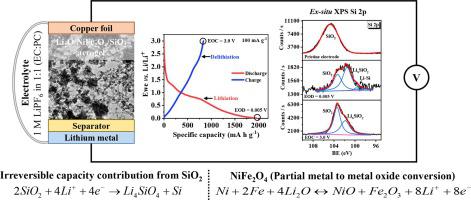当前位置:
X-MOL 学术
›
Appl. Surf. Sci.
›
论文详情
Our official English website, www.x-mol.net, welcomes your
feedback! (Note: you will need to create a separate account there.)
Capacity fading mechanism of Li2O loaded NiFe2O4/SiO2 aerogel anode for Lithium-ion battery: Ex-situ XPS analysis
Applied Surface Science ( IF 6.3 ) Pub Date : 2021-01-01 , DOI: 10.1016/j.apsusc.2020.147677
S. Balamurugan , N. Naresh , I. Prakash , N. Satyanarayana
Applied Surface Science ( IF 6.3 ) Pub Date : 2021-01-01 , DOI: 10.1016/j.apsusc.2020.147677
S. Balamurugan , N. Naresh , I. Prakash , N. Satyanarayana

|
Abstract The aerogel form of 0-5 wt.% of Li2O loaded NiFe2O4/SiO2 composite aerogel were successfully synthesized using the sol-gel process followed by the supercritical ethanol drying. The addition of small Li2O wt.% enhances the electrical conductivity of NiFe2O4/SiO2 composite aerogels. Based on the AC impedance analysis, the high conducting 5% Li2O + 95% [NiFe2O4/SiO2] composite aerogel with conductivity 2.1 × 10-11 S cm–1 was taken for the detailed analysis. We observed the maximum initial reversible discharge capacity of 930 mA h g-1, and it gradually fades to 370 mA h g-1 at 50th discharge. To elucidate the capacity-fading mechanism, the ex-situ X-ray Photoelectron Spectroscopy (XPS) technique is used to identify the chemical composition at different states of charge-discharge cycling. The capacity fading arises mainly from irreversible LixSiOy accumulation, which causes the loss of active lithium. Meanwhile, the metal to metal oxide conversion is partially reversible between Ni0 ↔ Ni2+, Fe0 ↔ Fe3+ during the subsequent cycles. To further support, the SEM images were taken for the respective electrodes, and the cell resistance and lithium diffusion coefficient (DLi+) was calculated from the electrochemical impedance spectroscopy (EIS) at the respective samples taken for ex-situ XPS analysis. The DLi+ gradually decreases from 1.8 × 10–13 cm2 s-1 to 9.6 × 10–14 cm2 s-1, and the cell resistance increases during the 1st to 10th discharge cycle. We conclude that the prolonged accumulation of irreversible LixSiOy phase will hinder the DLi+ in subsequent cycles, which leads to capacity-fading. The detailed results and electrochemical performance will be discussed.
中文翻译:

锂离子电池用Li2O负载NiFe2O4/SiO2气凝胶负极的容量衰减机制:异位XPS分析
摘要 采用溶胶-凝胶法和超临界乙醇干燥法成功合成了 0-5 wt.% Li2O 负载的 NiFe2O4/SiO2 复合气凝胶。添加少量 Li2O wt.% 提高了 NiFe2O4/SiO2 复合气凝胶的电导率。基于交流阻抗分析,采用电导率为 2.1 × 10-11 S cm-1 的高导电率 5% Li2O + 95% [NiFe2O4/SiO2] 复合气凝胶进行详细分析。我们观察到最大初始可逆放电容量为 930 mAh g-1,并在第 50 次放电时逐渐衰减至 370 mAh g-1。为了阐明容量衰减机制,使用异位 X 射线光电子能谱 (XPS) 技术来识别不同充放电循环状态下的化学成分。容量衰减主要来自不可逆的 LixSiOy 积累,导致活性锂的损失。同时,在随后的循环中,金属到金属氧化物的转化在 Ni0 ↔ Ni2+、Fe0 ↔ Fe3+ 之间是部分可逆的。为了进一步支持,拍摄了各个电极的 SEM 图像,并从用于异位 XPS 分析的各个样品的电化学阻抗谱 (EIS) 计算了电池电阻和锂扩散系数 (DLi+)。DLi+ 从 1.8 × 10–13 cm2 s-1 逐渐降低到 9.6 × 10–14 cm2 s-1,并且在第 1 至第 10 次放电循环期间电池电阻增加。我们得出结论,不可逆 LixSiOy 相的长期积累将阻碍后续循环中的 DLi+,从而导致容量衰减。
更新日期:2021-01-01
中文翻译:

锂离子电池用Li2O负载NiFe2O4/SiO2气凝胶负极的容量衰减机制:异位XPS分析
摘要 采用溶胶-凝胶法和超临界乙醇干燥法成功合成了 0-5 wt.% Li2O 负载的 NiFe2O4/SiO2 复合气凝胶。添加少量 Li2O wt.% 提高了 NiFe2O4/SiO2 复合气凝胶的电导率。基于交流阻抗分析,采用电导率为 2.1 × 10-11 S cm-1 的高导电率 5% Li2O + 95% [NiFe2O4/SiO2] 复合气凝胶进行详细分析。我们观察到最大初始可逆放电容量为 930 mAh g-1,并在第 50 次放电时逐渐衰减至 370 mAh g-1。为了阐明容量衰减机制,使用异位 X 射线光电子能谱 (XPS) 技术来识别不同充放电循环状态下的化学成分。容量衰减主要来自不可逆的 LixSiOy 积累,导致活性锂的损失。同时,在随后的循环中,金属到金属氧化物的转化在 Ni0 ↔ Ni2+、Fe0 ↔ Fe3+ 之间是部分可逆的。为了进一步支持,拍摄了各个电极的 SEM 图像,并从用于异位 XPS 分析的各个样品的电化学阻抗谱 (EIS) 计算了电池电阻和锂扩散系数 (DLi+)。DLi+ 从 1.8 × 10–13 cm2 s-1 逐渐降低到 9.6 × 10–14 cm2 s-1,并且在第 1 至第 10 次放电循环期间电池电阻增加。我们得出结论,不可逆 LixSiOy 相的长期积累将阻碍后续循环中的 DLi+,从而导致容量衰减。







































 京公网安备 11010802027423号
京公网安备 11010802027423号